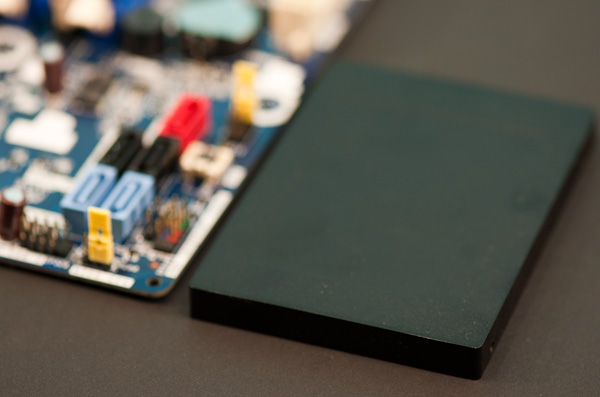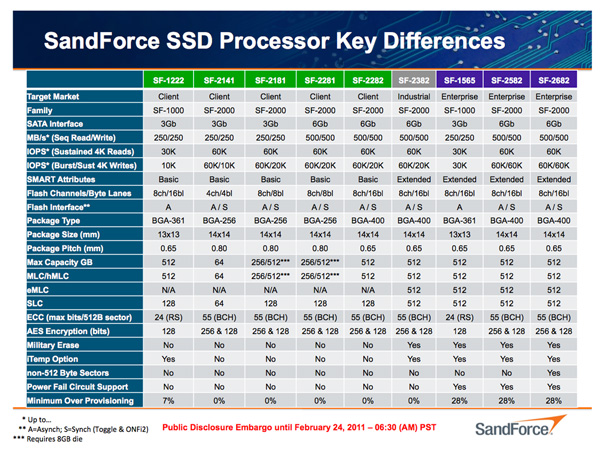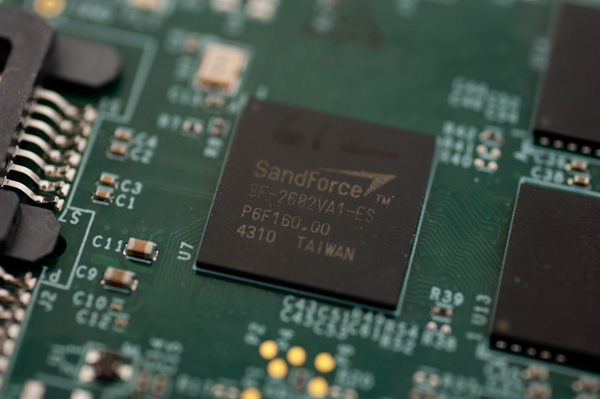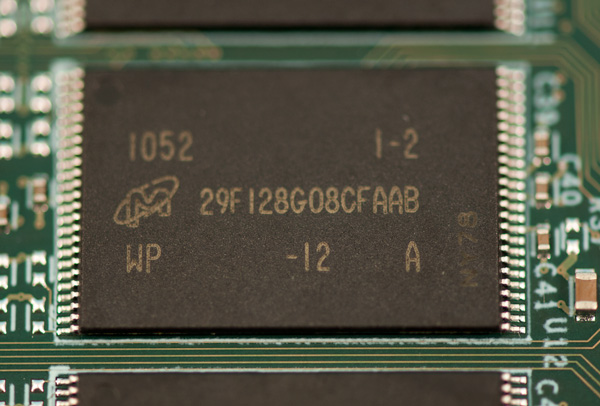OCZ Vertex 3 Preview: Faster and Cheaper than the Vertex 3 Pro
by Anand Lal Shimpi on February 24, 2011 9:02 AM ESTLast week OCZ pulled the trigger and introduced the world’s first SF-2000 based SSD: the Vertex 3 Pro. Not only was it the world’s first drive to use SandForce’s 2nd generation SSD controller, the Vertex 3 Pro was also the first SATA drive we’ve tested to be able to break 500MB/s on both reads and writes. Granted that’s with highly compressible data but the figures are impressive nonetheless. What wasn’t impressive however was the price. The Vertex 3 Pro is an enterprise class drive, complete with features that aren’t exactly in high demand on a desktop. As a result the V3P commands a premium - the drive starts at $525 for a 100GB capacity.
Just as we saw last round however, if there’s a Vertex 3 Pro, there’s bound to be a more reasonably priced non-Pro version without some of the enterprisey features. Indeed there is. Contained within this nondescript housing is the first beta of OCZ’s Vertex 3 based on a SandForce SF-2200 series controller. The price point? Less than half of that of the V3P:
| Pricing Comparison | |||||
| 128GB | 256GB | 512GB | |||
| OCZ Vertex 3 Pro | $525 (100GB) | $775 (200GB) | $1350 (400GB) | ||
| OCZ Vertex 3 | $249.99 | $499.99 | N/A | ||
At an estimated $250 for a 120GB drive the Vertex 3 is more expensive than today’s Vertex 2, but not by too much nor do I expect that price premium to last for long. The Vertex 2 is on its way out and will ultimately be replaced by the V3. And SSD prices will continue to fall.
What sets a Vertex 3 apart from a Vertex 3 Pro? Not all that much, but SandForce has grown a lot in the past year and instead of just a couple of SKUs this time around there are no less than seven members of the SF-2000 family.
You should first know that SandForce only produces a single die, the differences between all of the members of the SF-2000 family are strictly packaging, firmware and testing.
The main categories here are SF-2100, SF-2200, SF-2500 and SF-2600. The 2500/2600 parts are focused on the enterprise. They’re put through more aggressive testing, their firmware supports enterprise specific features and they support the use of a supercap to minimize dataloss in the event of a power failure. The difference between the SF-2582 and the SF-2682 boils down to one feature: support for non-512B sectors. Whether or not you need support for this really depends on the type of system it’s going into. Some SANs demand non-512B sectors in which case the SF-2682 is the right choice.
You may remember that our Vertex 3 Pro sample used a SF-2682 controller. That’s because initially all SandForce made were SF-2682s. Final versions of the V3P will likely use the cheaper SF-2582.
The SF-2200/2100 series are more interesting because of their lower target price points. You lose support for the supercap but that’s not as big of a deal on the desktop since you’re not working with mission critical data. The big difference between the 2200 and 2100 is support for 6Gbps SATA, the former supports it while the latter doesn’t. This is a pretty big difference because as we’ve seen, when paired with a 3Gbps controller the SF-2000 isn’t too much better than what we had with the SF-1000.
The other big difference is the number of byte lanes supported by the controller. The SF-2181 and above all support 8 NAND flash channels, however only the SF-2282 supports 16 byte lanes. Each NAND device is 8 bytes wide, supporting 16 byte lanes means that each channel can be populated by two NAND devices. This lets a single SF-2282 controller talk to twice as many NAND devices as a SF-2281.
There’s no performance difference between the 8 and 16-byte lane versions of the chip, it’s just a matter of pure capacity. Thankfully with 25nm NAND you can get 8GB of MLC NAND on a single die so both the 2281 and 2282 should be able to hit 512GB capacities (the 2281 simply needs higher density NAND packages).
The Vertex 3 sample we have here today uses the SF-2281. Our sample came configured with sixteen 16GB Micron 25nm ONFI 2.0 NAND devices. Remember that while both Intel and Micron own the 25nm fabs, the two companies are providing different specs/yields on 25nm NAND. The 25nm Micron stuff is rated at around 3,000 p/e cycles from what I’ve heard, while the Intel 25nm is rated at 5,000. The main difference here is that the Micron is available in great quantities today while the Intel 25nm isn’t.
RAISE: Optional
One other difference between the SF-2500/2600 and the SF-2100/2200 is the optional nature of RAISE. You'll remember that in order to allow for lower quality NAND SandForce stripes a small amount of redundant data across the array of NAND in a SF-1000/2000 drive. SandForce never stores your actual data, rather a smaller hash/representation of your data. When your data is compressed/deduped for storage, SandForce's controller also generates parity data equal to the size of a single NAND die in the array. This process is known as RAISE (Redundant Array of Independent Silicon Elements) and it allows you to lose as much as a full NAND die worth of data and still never see a bit of data loss from the user's standpoint. At 25nm however a single die can be as large as 8GB, which on a lower capacity drive can be a significant percentage of the total drive capacity.

With the SF-2100/2200, SandForce allows the manufacturer to disable RAISE entirely. At that point you're left with the new 55-bit BCH ECC engine to do any error correcting. According to SandForce the new BCH ECC engine is sufficient for dealing with errors you'd see on 25nm NAND and RAISE isn't necessary for desktop workloads. Drive makers are currently contemplating what to do with RAISE but as of now the Vertex 3 is set to ship with it enabled. The drive we have here today has 256GB of NAND, it'll be advertised as a 240GB drive and appear as a 223.5GB drive in Windows.
Here We Go Again: 4KB Random Write IOP Caps
With the SF-1200 SandForce capped the peak 4KB random write speed of certain drives while negotiating exclusive special firmware deals with other companies to enable higher performance. It was all very confusing as SandForce shipped initial firmware revisions with higher performance and later attempted to take that performance away through later firmware updates.
If you pay attention to the table above you’ll notice that there are two specs for 4KB random write IOPS: burst and sustained. The burst value is for around 15 seconds of operation, the sustained is what happens when the firmware initiated performance cap kicks into action. By default the SF-2100/2200 drives have a cap of 20,000 IOPS for 4KB random writes. After a period of about 15 seconds, the max performance on these drives will drop to 20K. The SF-2500/2600 controllers are uncapped, max performance can remain at up to 60K IOPS.
The beta Vertex 3 review sample I have here today manages around 45K IOPS in our 4KB random write test. That test runs for 3 minutes straight so obviously the cap should’ve kicked in. However it didn’t.
I asked SandForce why this was. SandForce told me that the initial pre-release firmwares on the SF-2200 drives don’t have the cap enabled, but the final release will put the cap in place. I also asked SandForce if it was possible for one of its partners to ship with a special firmware build that didn’t have the cap in place. SandForce replied that anything was possible.
I asked OCZ if this meant the drive I was testing wasn’t representative of final, shipping performance. OCZ stated very clearly that performance will not change between the drive I have today and the drive that goes on sale in the next 2 months. To me this sounds like SF and OCZ have struck another exclusive firmware deal to ensure slightly higher performance on the Vertex 3 compared to a standard SF-2200 based drive.
SandForce wouldn’t comment on any existing agreements and OCZ said it couldn’t get SandForce to confirm that the V3’s performance wouldn’t change between now and its eventual release. Based on what we saw last time I expect SandForce to offer the 60K IOPS firmware to all partners that meet certain order size commitments. Order enough controllers and you get a special firmware, otherwise you’re stuck with the stock SF-2200 firmware.
Of course this makes things very confusing for those of you looking to shop around when buying a SF-2200 drive. I do wish SandForce would just stick to a single spec and not play these sorts of games but that’s just how business works unfortunately.
The good news is that for most desktop workloads you don’t really benefit from being able to execute more than 20K IOPS, at least in today’s usage models.
















85 Comments
View All Comments
FunBunny2 - Friday, February 25, 2011 - link
If you're running a really relational database, then random performance is what matters.iwod - Friday, February 25, 2011 - link
Yes, but 99% of Normal World Users dont run Relational DB. And those who ran the DB would properly search for faster Random I/O instead.jimhsu - Friday, February 25, 2011 - link
It ... depends. Real world performance is really complicated:1. You can have any combination of read or writes, sequential or random, going on at once.
2. You have both synchronous IO (this read must be done before that read) and asynchronous IO (this reads all need to be executed, but in whatever order).
3. You have other bottlenecks coming into play - CPU, memory, GPU, ...
All the basic metrics (seq read/write, random read/write) are important. As well as performance with mixed read/write workloads (this is in fact the most difficult aspect to bench). Hard drives have been around for decades, so we have well-established metrics for determining performance. Flash SSDs have been around for less than 10, and in the consumer market, less than 3 years.
iwod - Friday, February 25, 2011 - link
Yes Performance is Complicated. But it doesn't matter in this context. We are trying to find the bottleneck and fastest Storage Hardware within today's Applications. And the Anandtech Bechmarks, is basically just a batch script that execute common task that we do. Time and Average it as Scores.Time and Time again i have asked why some brand controller, labeled as "crap" by most of us, continuously to perform extremely well, and in many cases even better then Sandforce on Anand Real World Benchmarks ( Read Toshiba Controller in Kingston V+ aka Apple's MBA SSD)
Chaser - Friday, February 25, 2011 - link
As SSDs become more common and second/third generations of models are starting to appear graph bars showing numerical values are beginning to got lost in haze. How would a "PC Mark Vantage score" difference of 3 points equate to an improved and noticable user experience? So while pages of "faster, higher" values might look appealing I am more lost now than anything else.For me, I enjoy reading conclusions similar to GPU results and comparisons. Such as, "If you have a Sandforce 1200 drive upgrading to this next generation wouldn't result in much or more of a noticable change on the average desktop enthusiast or gaming computer.
iwod - Friday, February 25, 2011 - link
The difference of 3 Points will be the same. Because it is within Margin or Error.Read up my post about you.
MamiyaOtaru - Friday, February 25, 2011 - link
"prices will continue to fall"been waiting for them to become reasonable for years now, and this gets repeated when they go up?
I'm hoping for great things from memristors
Spazweasel - Monday, February 28, 2011 - link
So here's a question. With these solid state hard drives bursting to near the maximum transfer rate of SATA3 and completely eclipsing spinning media, the Holy Grail is going to be to approach RAMdisk speed.I'd be curious to see how a drive like this compares to, say, a 4gb RAM disk which has been formatted with the same file system. I imagine the RAMdisk driver and operating system will matter a great deal for such a baseline, but if a RAMdisk driver and config can be settled upon, this would make a very interesting comparison.
As far as I can tell, the SATA3 standard, with 6Gb/sec (little B) will saturate at about 525MB/sec (big B). DDR3/1333 will do so at 10667MB/sec. 20 times faster, right? Well... maybe. This is where file system and driver overhead will loom large. RAID will fatten up the pipe, and ultimately PCIE 2.0 16x will peak at 8192MB/sec (big B). Since PCIE 2.0/16x is close to DDR3/1333 in transfer speeds, in theory (that wonderful place where everything works), the aforementioned Holy Grail is at least in sight at the horizon.
So yeah, I'm curious about RAMdisks vs. fast SSDs in RAID. Just as an exercise.
iwod - Tuesday, March 1, 2011 - link
I know this is old, but can you brief us on WHAT THE HELL HAPPEN to Intel SSD Controller?Was it always suppose to be a Marvel Controller + Intel Firmware? Are is there REAL G3 coming soon?
WintersEdge - Wednesday, March 9, 2011 - link
So this is a preview, right? Although it's quite complete like a full review... Nevertheless, you'll do another review when the product actually comes out? Right? Or what? If so, will you add your energy use test, like you've done for SSD reviews in the past? I know it'll be very small but then again, all the differences in performance are also very small to an end user just doing ordinary tasks.Thanks